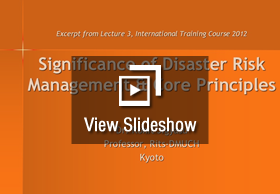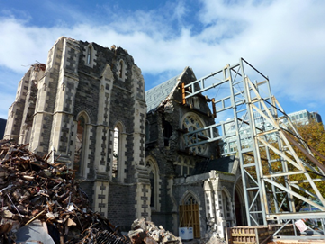

This section outlines the need for an integrated approach for disaster risk management of cultural heritage by identifying the links between disaster risk management, sustainable development and heritage conservation and management.

The integrated disaster risk management process

Diagrammatic representation of integration of disaster risk management planning into overall site management and regional planning.

The core lecture should present the various links between disaster risk management, cultural heritage and the urban environment through secondary case examples, which may be local or global depending on the focus of the course. This lecture should be approached as being central to the first module and the various other lectures and presentations should link back to the principles and concepts introduced at this stage. In case of a short term course or seminar, this lecture could potentially summarise all the other content of the module. Diagrammatic representations highlighting various relationships would be particularly useful in such a format. The lecture should be illustrated through secondary case examples to illustrate various approaches and principles
Significance of Disaster Risk Management & Core Principles
Excerpt from Lecture 3, International Training Course 2012
Instructor: Rohit Jigyasu



Remains of the Anglican Christchruch Cathedral, used as a secondary case example (Bryan Lintott)
This section outlines the need for an integrated approach for disaster risk management of cultural heritage by identifying the links between disaster risk management, sustainable development and heritage conservation and management.
It introduces principles such as:
Significance of Disaster Risk Management and Core Principles
Instructor: Rohit Jigyasu, International Training Course 2011
Duration: 80 minutes
The objective of this lecture was to engage participants in a discussion which would make them appreciate the need for an integrated approach towards disaster risk management, and then introduce the disaster risk management cycle which would form the basis for the rest of the course framework. This is a critical segment of the course. The presentation highlighted the issue that cultural heritage is under increasing threat from various catastrophic events; both natural and human induced such as earthquakes, floods, cyclones, fires, armed conflicts and terrorism. This was illustrated through examples from various parts of the world including some recent disasters such as Christchurch (New Zealand), Tohuko (Japan) and Haiti.
The presentation further highlighted various challenges in reducing risks to cultural heritage before, during and after disasters. Lastly, risks to cultural heritage during the post-disaster recovery phase were elaborated through examples. These included difficulties in undertaking damage assessment of heritage structures and challenges in taking decisions for recovery of cultural heritage and lack of integration of cultural dimensions in post-disaster reconstruction.
At the end of the lecture the disaster risk management cycle was introduced. This cycle highlights various activities to be undertaken for the prevention and mitigation, preparedness, response and recovery phases.
The lecture was followed by a site visit to the World Heritage Site of Kiyomizu-dera, where participants were introduced to their first workshop dealing with the initial stages of risk assessment, and highlighting relationships between disaster risks, vulnerabilities and hazards.

